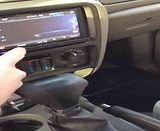stvrob
Member
- May 28, 2014
- 139
I understand what you mean. Batteries in series vs parallel and all. But the battery is only discharging current when the engine is not running, When starting the vehicle, the battery delivers an enormous current, much more than even the powerful audio amplifier system. When the engine is running (assuming the alternator is capable of the task), the battery is always charging. A smart charging system is always trying to taper off the charge and not needlessly heating up the battery (at 14+ volts) when its already fully charged.
When running, all the battery contributes to the system is to act as a giant capacitor. It certainly smooths out what would otherwise be a pulsing voltage from the alternator, but even a single battery is overkill for that sole task. A second battery would certainly help you run the audio system for a longer period of time if the engine is not running, perhaps that is the reason for the second battery? But if the audio system is using as much power as he described earlier, it is going to need a jump start after just a few minutes of use anyway, so he'd be better off with one of the batteries isolated.
I think he ought to look into a DC/DC converter and step it up to 24-28 v for the amp.
When running, all the battery contributes to the system is to act as a giant capacitor. It certainly smooths out what would otherwise be a pulsing voltage from the alternator, but even a single battery is overkill for that sole task. A second battery would certainly help you run the audio system for a longer period of time if the engine is not running, perhaps that is the reason for the second battery? But if the audio system is using as much power as he described earlier, it is going to need a jump start after just a few minutes of use anyway, so he'd be better off with one of the batteries isolated.
I think he ought to look into a DC/DC converter and step it up to 24-28 v for the amp.

